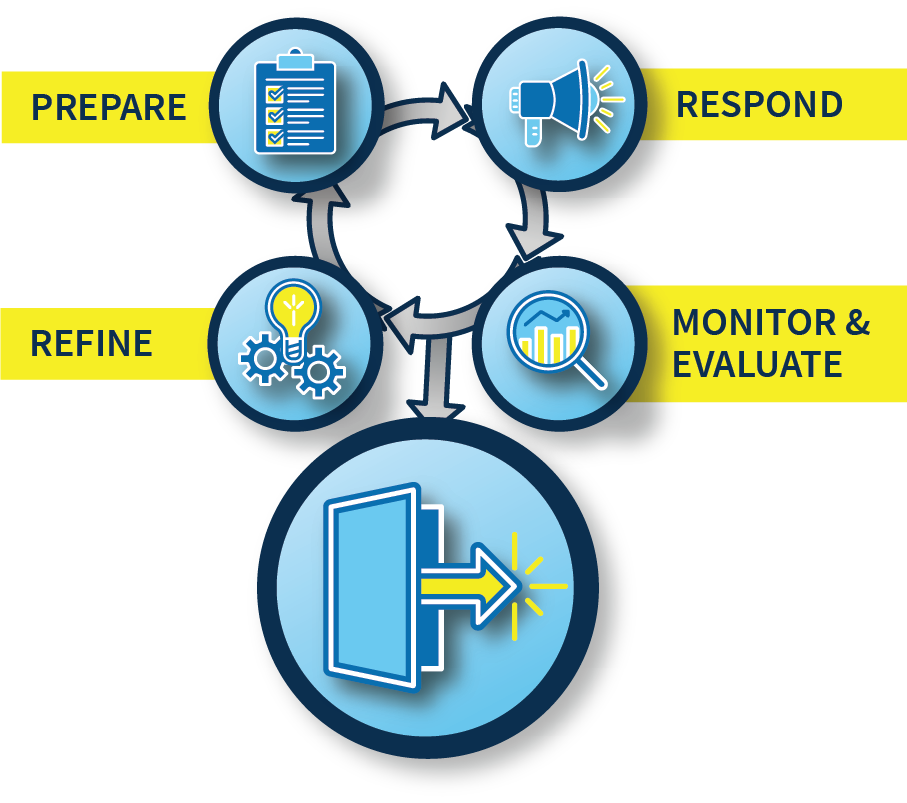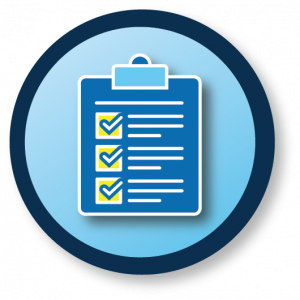CLOSE and TRANSITION the Campaign



ASSESS CAMPAIGN IMPACT

THANK THE COMMUNITY

REVIEW AND SHARE LESSONS LEARNED

TRANSITION TO RECOVERY AND CONTINUITY OF OPERATIONS

PREPARE FINAL REPORT
Assess Campaign Impact
The impact evaluation, including the questions assessed and data collected, should be rooted in the goals and objectives set by the oversight team, and pursued by the CMT at campaign onset.
KEY DECISIONS AND ACTIVITIES TO ASSESS CAMPAIGN Impact
- Establish the evaluation framework. Gather stakeholder input (i.e., from the oversight team, the CMT, the campaign team, federal partners, and community members) obtained throughout the campaign and/or at the outset of evaluation planning, and review the campaign logic model and campaign goals, to determine the evaluation purpose and approach (Centers for Disease Control and Prevention [CDC], 2011).
- Include the community advisory board and/or members of the audience of focus in the framework development.
- In the composition of the evaluation framework, consider constraints such as budget, timeline, and external influences to understand the scope, process, and potential mediating factors of the campaign.
- The evaluation frame work should be structured based on the levels of accountability for the overall campaign (e.g., the CMT, the oversight team, participating federal agencies).
- Develop evaluation questions. Well-designed questions will focus the evaluation on the information most salient and relevant to the evaluation purpose. Evaluation questions should:
- Be measurable (i.e., the data required to answer them is available to the evaluation team).
- Have the possibility for multiple answers.
- Solve a problem or a need for the oversight team, the CMT, participating federal agencies, and/or the campaign’s community of focus (Issel, 2009).
- Determine the design. Depending on evaluation purpose and constraints, determine the most appropriate design.
- Like scientific research, evaluation designs can be observational, quasi- experimental, or experimental.
- Use pre-test/post-test evaluations as needed to measure change (if leveraging this option, pre-tests should be included in the campaign preparation phase).
- Identify dependent variables. In addition to the evaluation questions, defining variables to measure will focus and streamline the evaluation to ensure results are most relevant and useful to all stakeholders.
- Examples of dependent variables to evaluate in a PHE community activation campaign can include key health outcomes such as lives saved, hospitalizations, emergency department use, length of stay, and disease morbidity; in addition, audience sentiment outcomes such as trust in the government can also be evaluated as dependent variables.
- Gather data. Establish a data collection plan to include the timeline, participants, resources, and processes.
- Determine what type of data will be used (i.e., primary, secondary, or both).
- Identify datasources, and collection methods (e.g., surveys, focus groups, claims analysis).
- For primary data collection, set participant recruitment targets and plan for recruitment activities.
- Be aware of factors that may affect data quality (e.g., instrument design, interviewer bias, data management, routine error).
- Assess evidence. Organize, classify, and analyze the data collected.
- Synthesize findings to draw conclusions around the evaluation questions and tell the evaluation story.
- Report findings. Ensure evaluation results are accessible and useful to all relevant stakeholders.
- Document lessons learned for improvements to future campaign evaluation exercises (CDC, 2011).
Thank the Community
This recognition lays the foundation for future partnerships with public officials and government agencies. Some relationships may naturally end when the campaign closes. Others, due to their unique insights or community strength, may provide significant value to federal, state, or local agencies and would be beneficial to maintain over time to meet other policy or program goals.
Additional Information About Thanking the Community
- Send a personalized thank you note.
- This is a small, low-cost gesture that goes a long way to show appreciation.
- Recognize partners on print or web materials, and/or on social media.
- Explain how and why they were crucial to the success of the campaign.
- Invite community partners to attend additional trainings, professional development events, or conferences.
- Understand that community partners are often vulnerable to the economic impacts of a PHE. Operating budgets may shrink, and staff may be lean. Recognizing stressors in words and actions can strengthen the relationship by bolstering trust.
- Acknowledge burnout among community- based service providers.
- Simply recognizing that burnout is legitimate reflects consideration and understanding of how circumstances place a real toll on partner organizations, their leadership, and staff.
- Collaborate on manuscript preparation.
- Consider that community partners often face challenges in having their findings disseminated, particularly via peer-reviewed academic journals. One meaningful way to thank the partner could be to offer support for manuscript preparation and submission or to co-author content. This could help other communities benefit from the successes and challenges of the partnership.
|
Review and Share Lessons Learned
The impact evaluation, including the questions assessed and data collected, should be rooted in the goals and objectives set by the oversight team, and pursued by the CMT at campaign onset.
Additional Information About Thanking the Community
Findings from these lessons-learned evaluations in the close-out phase can be highly informative resources that assist development and implementation of future project operations, strategic planning, goal setting, and tactical decision-making for a reinstated campaign or a public health emergency (PHE). See the tool Lessons Learned Methodology Worksheet for example lessons learned methodologies and a planning worksheet.
|
Transition to Recovery and Continuity of Operations
Additional Information About Transitioning to Recovery and Continuity of Operations
Transferring all assets to the oversight team or its government designee, and documenting processes followed in the transferal support government archival efforts. It can facilitate revival of the campaign framework and partner relationships in the future, should circumstances require additional community activation to address the PHE. Additionally, all records and information not publicly available that were produced during the campaign must be retained in case a request to obtain those records is submitted under the Freedom of Information Act (1967) (FOIA request).
|
Key Decisions and Activities to Transition the Campaign
- Inventory and coordinate the transfer of all assets. Stakeholders in a large project often share assets, both internally and externally. Maintaining access to these assets for continuity of operations is vital to successful project completion.
- Scheduling and oversight of asset transfer will ensure a seamless transition from CMT daily operations to the oversight team’s close-out.
- Example assets include, but are not limited to:
- Digital content
- Website artifacts
- Software repositories
- Collaboration tools
- Social media accounts
- Audio and video files
- Identify and document procedures the campaign established for required activities such as content creation, issue reporting, task generation, requirements gathering, and reporting.
- Conduct interviews before stakeholders leave the campaign to transfer implicit knowledge of processes and procedures and determine whether to continue those activities through the end of the effort.
Prepare Final Reports
Data tracked in the project dashboards, testimonies from individuals or community leaders, and specific goals and outcomes outlined during the strategic preparations all serve as resources to construct reports that can address different stakeholders’ interests in the campaign’s processes and outcomes. It may be important to explain how or whether certain campaign resources will remain available for review and use, particularly if the PHE is not fully abated or the health risks remain at a lower level of intensity or impact.







